Atalanta emboldened their strong Serie A season so far with another win. They overcame Sassuolo scoring four goals in the first half, showing off a strong defensive performance and inspired attacking actions.
Sassuolo on their end found it hard to be released from the intense press applied by Atalanta and got stuck midway being unable to create opportunities in the opposition’s half.
This tactical analysis aims to allocate the main tactics used by both managers and show how Atalanta excelled Sassuolo.
Line-ups
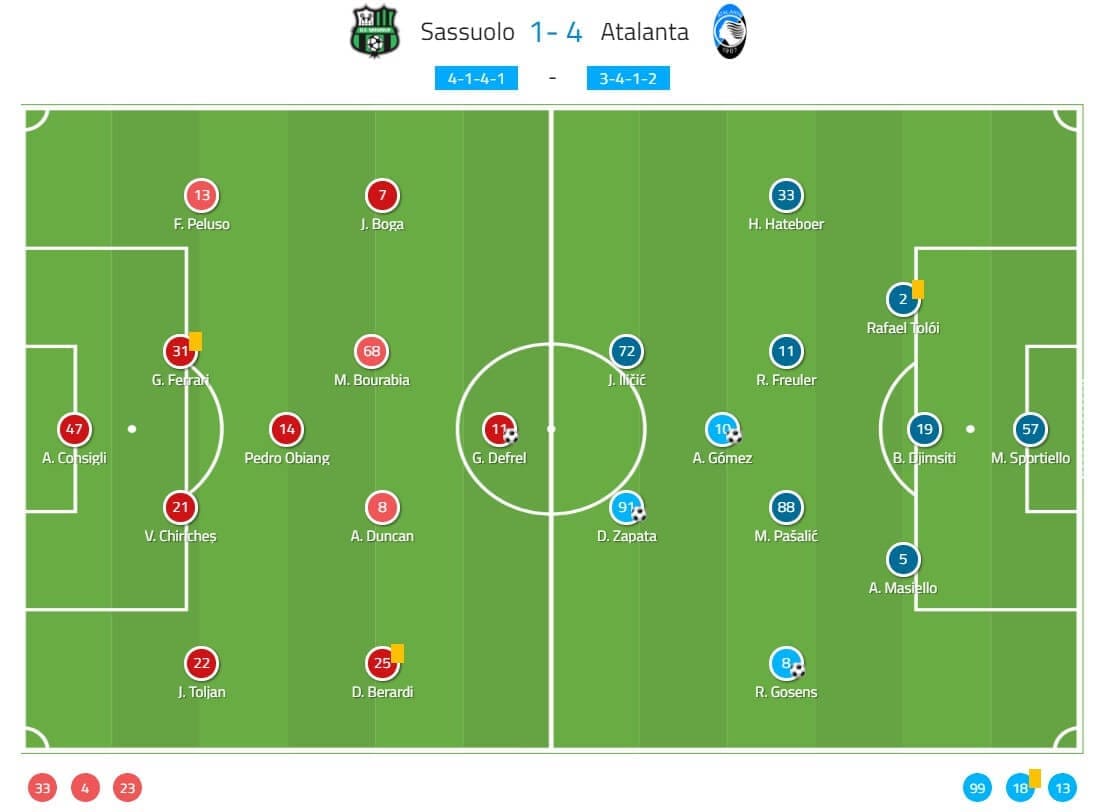
Roberto De Zerbi lined Sassuolo up in a 4-3-3/4-1-4-1 formation. Andrea Consigli was at the goalkeeping spot with a four-man defensive line containing Federico Peluso as the left-back, Gian Marco Ferrari and Vlad Chiricheș as the central duo, and Jeremy Toljan operating on the right. Pedro Obiang was positioned centrally and was responsible for dropping back in the defensive midfield frequently. Mehdi Bourabia and Alfred Duncan were supporting him centrally, whilst being flanked by Jeremie Boga and Domenico Berardi. Grégoire Defrel was at the tip of the attack.
Gian Piero Gasperini didn’t surprise anyone with the formations and relied on a 3-4-1-2/3-4-2-1. There was a surprise when it came to the starting XI though- Marco Sportiello started in goal instead of Pierluigi Gollini. The three-man backline saw Andrea Masiello, Berat Djimsiti and Rafael Tolói next to each other. In the midfield line were operating Robin Gosens, Mario Pašalić, Remo Freuler and Hans Hateboer. One of the best performers Alejandro Gómez was drifting around the box with Duván Zapata and Josip Iličić as offensive support.
Atalanta were completely dominating throughout the first half, taking control of the game, retaining possession and creating lots of opportunities. Sassuolo couldn’t react properly on the press applied by their opponents and could hardly reach the final third and produce any goal scoring opportunities.
Roberto De Zerbi made two changes with the start of the second half and his team noticeably improved their performance. They increased the pace and were in possession more frequently which forced Atalanta to put more defensive efforts and allow the game in their own half. This wasn’t enough though, as the guests pulled out a strong performance at the back and allowed only one goal despite the pressure.
Atalanta’s press neutralised Sassuolo’s pacey attack
From the beginning, both teams started circulating the ball mainly in the central areas. Sassuolo were the first to try applying a high press and pin Atalanta’s defenders back in their own half. This would force the Atalanta players to send the ball back frequently, which turned out in their favour. It allowed them to take control of the game and build up smoothly.
They were retaining possession by using short pass combinations and switching flanks. Atalanta were constantly pressing and covering the passing lanes which troubled Sassuolo’s attacking actions. They could hardly get time on the ball and were struggling passing it through their opponents’ midfield line.
Sassuolo were trying to release the press by switching flanks and sending long balls, but due to Atalanta’s efficient man-to-man marking strategy, they didn’t have the chance to reach the final third too often. The guests’ three-man defensive line was usually highly positioned when in possession, but perfectly timed their movements back during defensive transitions.
In the second half, as Atalanta would allow the play in their own half more often, they conceded more shots as a result. The well-structured five-man defensive line, though, didn’t allow Sassuolo’s players too close to the goal. Atalanta’s low block and limited space between the lines forced the Black and Greens to shoot from outside the box. This resulted in 75% of their shots coming from outside the box and decreasing their shot accuracy.
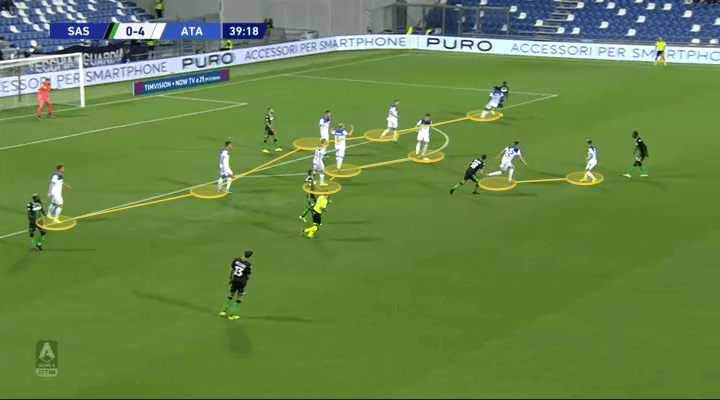
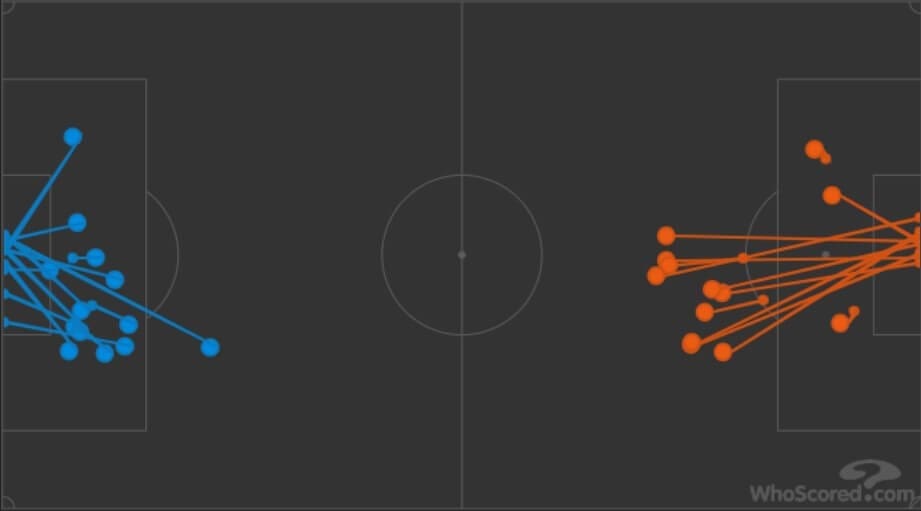
The Sassuolo players gained their confidence and creativity and managed to release the press. Their passing accuracy increased and they did better in sending long balls forward. This forced La Dea’s players to apply the high press and try to stop their attacks in the beginning.
Atalanta’s forward actions
Atalanta would retain possession mostly using the centre-backs and then circulating the ball on the right between Freuler, Tolói, and Hateboer. Once they reached out the opposition’s half they would often quickly transition to the left side and finish off their attacks from there where 54% of their shots came from.
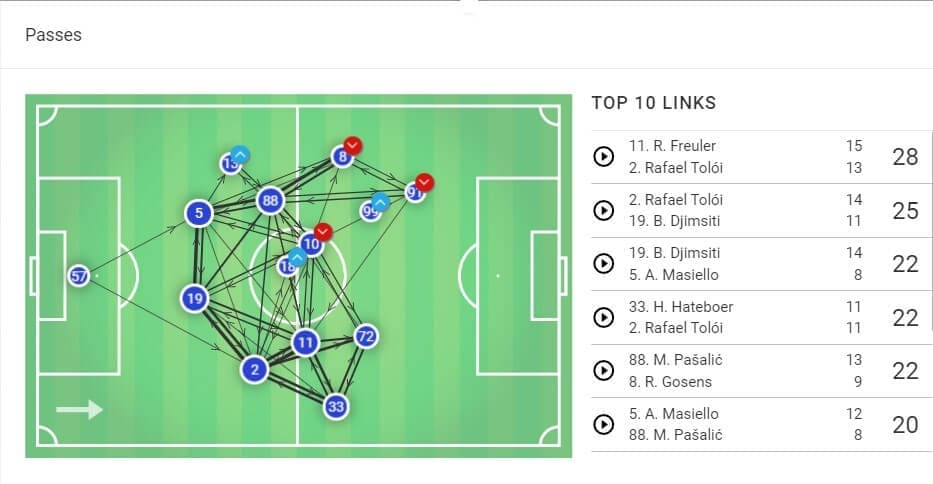
To help out with these actions there was Gómez who would use his individual skills to dribble past the defenders and shoot. His work under pressure and ball control made him responsible for two of Atalanta’s four goals. He would be covering the left half-space and move off the ball in order to receive it or use link-up-play and quickly pass it to the uncovered spaces.
They would spread out wide and stretch Sassuolo’s defensive line, opening gaps in the half-spaces. Another part of their attacking strategy would be the player rotation on the flanks. They would often use link-up-play to drag players out of position and use their movement off the ball all over in order to distribute the ball deeper in the opposition’s half.
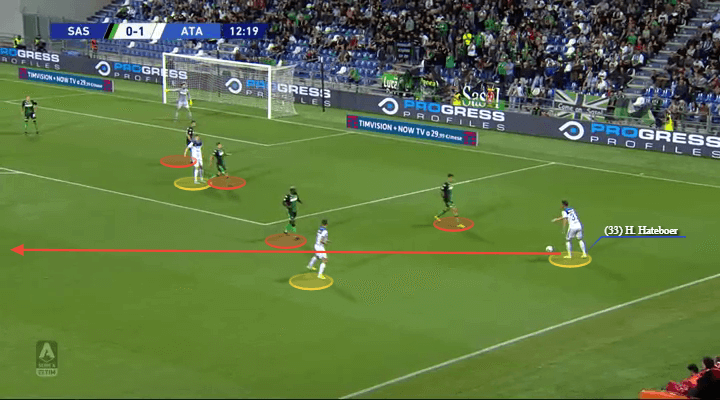
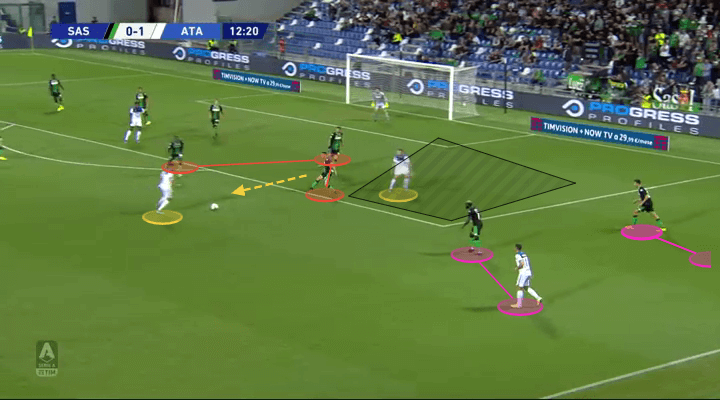
Sassuolo’s defensive awareness
Sassuolo have had struggles in their defence since the start of the season. They experience difficulty in putting enough pressure on the ball carrier and marking their opponents properly. Their players often struggle to respond quickly to the applied pressure, especially by more skilful players, and this forces them into both individual and collective errors.
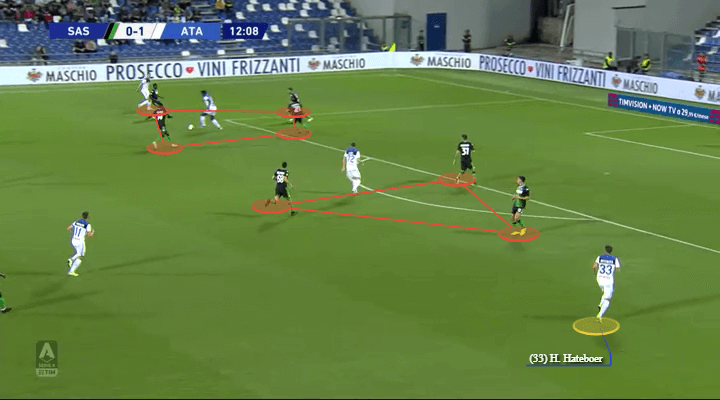
As it happened against Atalanta, they would allow themselves to being stretched out wide or dragged out of position frequently which would be focal for their structure. They would sometimes drop a fifth player as a support to the defensive line. The lack of balance between the midfield and the defensive line would result in an uncertain marking strategy. They often had to rely on the physicality of the midfielders in 1 vs 1 situations and are caught off-guard.
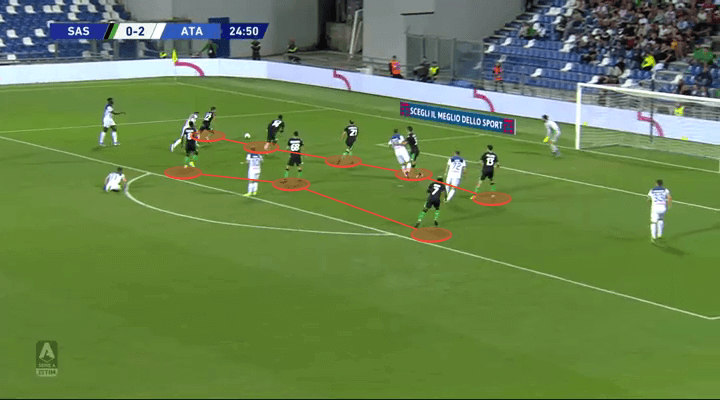
They would circulate the ball on the right mostly using the right-back Jeremy Toljan, with his 93% passing accuracy he helped in retaining possession and to distribute the ball further. This affected his defensive performance though. He would frequently neglect his defensive responsibilities and his decision-making in certain situations was poor. Losing possession in Sassuolo’s defensive third and missing out on applying pressure afterwards, resulted in him being the reason for conceding a few goalscoring opportunities.
Sassuolo’s press-releasing efforts and technical abilities
Atalanta performed pretty solid defensively. They would tightly mark their opponents in the box and limit the space between the lines. They were quickly re-structuring should Sassuolo break their back line’s structure. Due to the five-man defensive line, they were able to initially cover wider areas and then commit more players into marking the ball carrier if needed without risking leaving gaps.
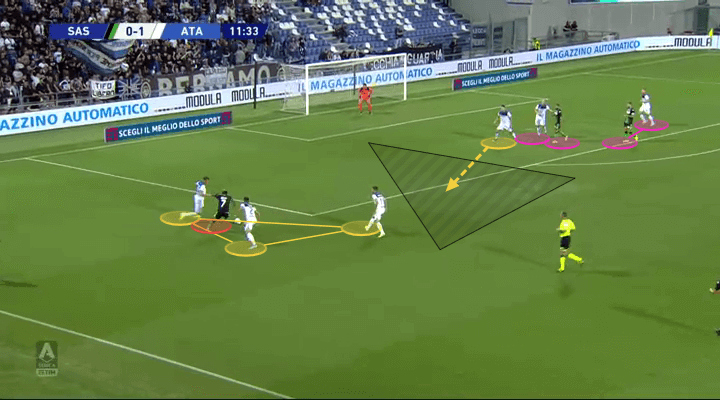
In the second half, being 0-4 down, Sassuolo noticeably increased their pace and passing accuracy, which resulted in them finally being able to break through Atalanta’s defence. They used a similar strategy of spreading out to the wings then providing the ball centrally. La Dea allowed the play in their own half more frequently and they had to be compact when defending on the edge of the box. Most of Sassuolo’s created chances came from overloading the central areas. They also started committing more players in the box during attacking set-pieces.
Pre-game, it was expected that Sassuolo would get something out of the game if they hold on to the ball in the opposition half. They couldn’t do that in the first half, but their performance immediately changed once they gained more confidence on the ball and started to allocate the open spaces in the final third.
Conclusion
Both teams were expected to implement their attack-minded style of play. Atalanta managed to do it better and outperformed Sassuolo using an intense press and quick ball circulation. Despite getting back on track by increasing the pace and the passing accuracy, the home team couldn’t score their second-half opportunities and left without a single point.

If you love tactical analysis, then you’ll love the digital magazines from totalfootballanalysis.com – a guaranteed 100+ pages of pure tactical analysis covering topics from the Premier League, Serie A, La Liga, Bundesliga and many, many more. Buy your copy of the September issue for just ₤4.99 here



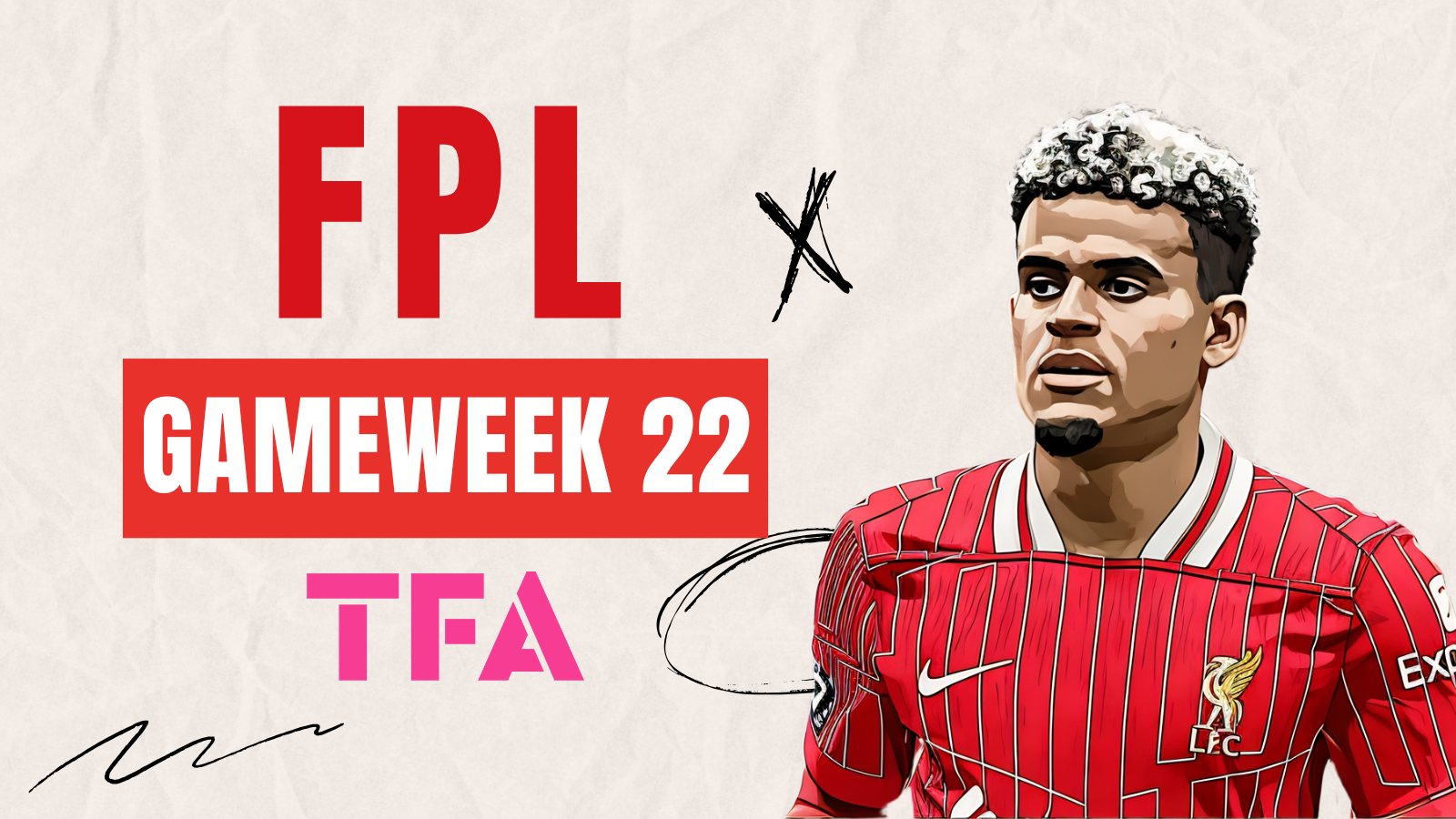
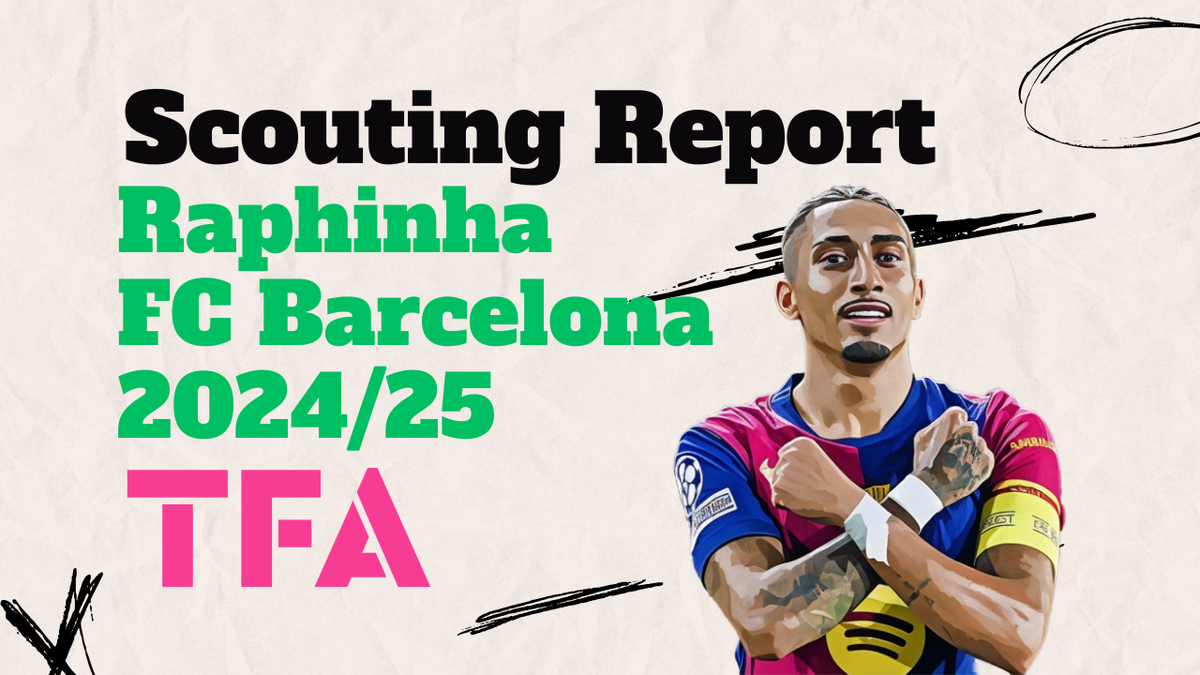
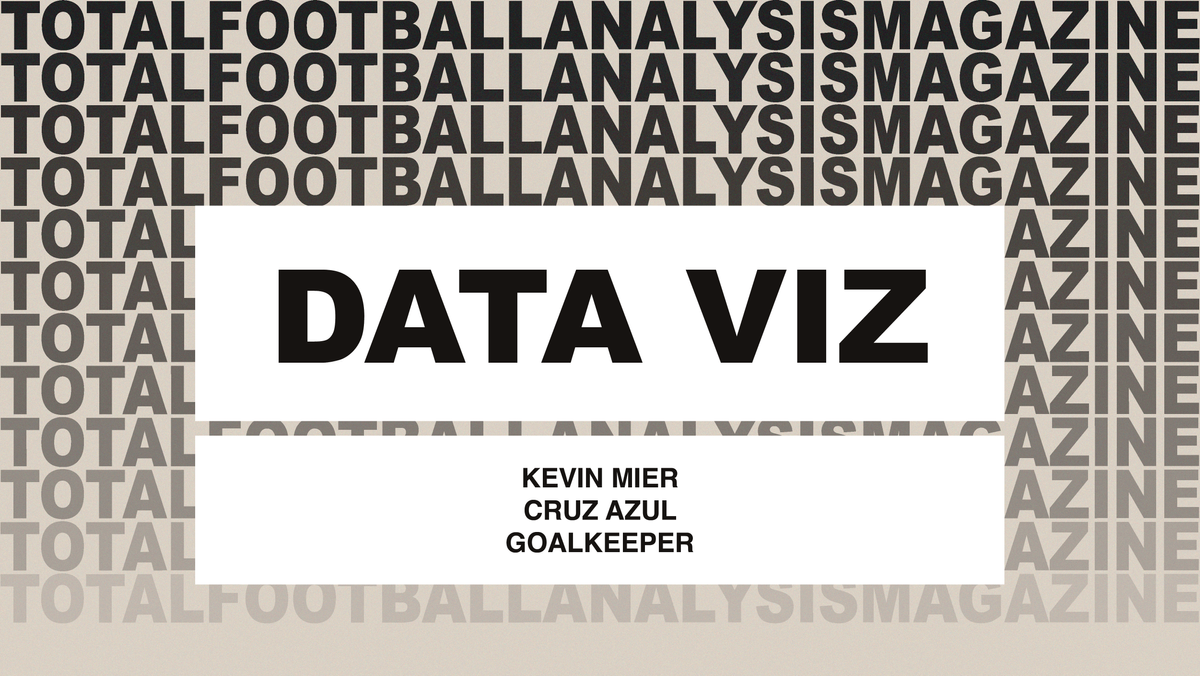
Comments